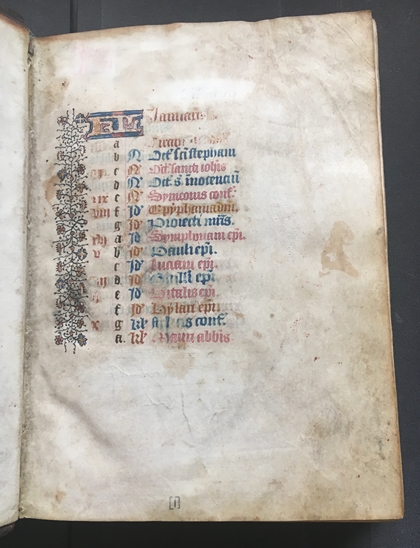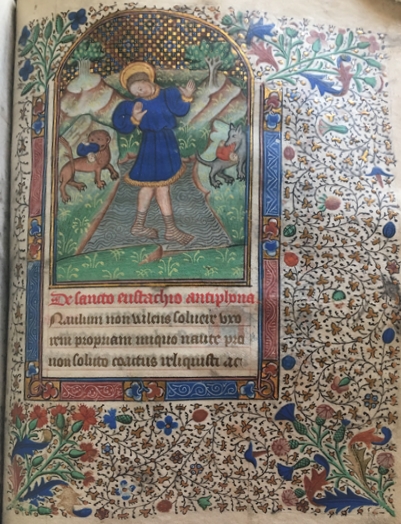UTS Manuscripts Student Series Post 1 of 4, by Eleanor Stern (Barnard College 2019)*
Inside of UTS MS 051, a fifteenth-century French book of hours believed to have belonged to King Henry III, now housed at the Burke Library, I expected to find certain kinds of illuminations. Most books of hours begin with a calendar, each month marked by illustrations of the the zodiac or of seasonal occupations (Gunhouse). But, as I turned its pages in Burke’s special collections reading room, I saw that the calendar was surrounded by floral and geometric motifs.

The floral motifs were skilfully illuminated, but conspicuously detached from the human activities of the calendar year. Though these illuminations take up only the center of each folio of the calendar, they are surrounded by substantial margins, so that the red, blue, and gold writing that marks each saint’s feast day floats island-like amid blankness. As I continued to turn the pages—past the gospel readings, past the hours of the virgin and the office for the dead, past luxurious full-page illuminations marking each section with ultramarine and gold—the book hewed more or less to what is expected in the genre (Gunhouse). It was atypical mostly in its luxuriousness. Use marks decreased with each passing page, as if its medieval owners had begun each day with the full intention of piety and prayer, only to get distracted somewhere around terce. And then, at the back of the book, (where there were few use marks to be found), I came across something even less expected than the abstract blankness surrounding the calendar pages. Here on f143 was a full-page illumination of St. Eustace, or “Eustachio,” as the illuminator has labeled him.

Eustace stands ankle-deep in a river, water rippling over his feet. He is clothed in ultramarine, his head set against a golden halo. Trees grow behind him on pastoral-looking hills of malachite, resembling the ones surrounding the Virgin Mary and her cousin Elizabeth in a visitation scene on f32. But this scene has none of the tranquility of that previous one. Eustace’s arms are raised in distress. His feet point towards one bank of the river, while his head twists backwards at an odd angle towards the other. On closer inspection, it becomes clear why. On each grassy bank, an animal—a wolf and a lion, it appears—holds a small child in its mouth. One child wears red, the other blue, and each lies limp, his head upside-down. The illuminator has captured Eustace in a scene of martyrdom: the moment where his two sons are carried away by wild animals (Shuffleton). St. Eustace is said to have begun his life as a Roman soldier named Placidas, working in service of the emperor Trajan. One day, Eustace/Placidas caught sight of a deer with a crucifix aglow among its antlers. This experience converted him suddenly to Christianity, and his family joined him in this new faith, in spite of warnings that Satan will test him. And test him Satan does: first he loses his property and servants, then his family. After finally being reunited with his family by the emperor Hadrian, Eustace still refuses to denounce his faith, and as punishment is roasted to death inside of a giant hollowed-out brass bull. The moment portrayed in MS 051 is the one in which he loses his sons to wild animals (Shuffleton). This Job-like series of tribulations reminded me of the abstraction surrounding this manuscript’s calendar. Books of hours, made to assist individual prayer, usually contain expressive images for meditation (Gunhouse). This one is no exception. F62, for instance, shows Christ being nailed to the cross, his body riddled with wounds to induce visceral responses.

Yet, in the narrative of Eustace slowly losing all he has in favor of an abstract faith, and in the wide margins surrounding each day of the year, this book promotes a kind of meditative blankness as well. Rather than solely creating feelings of devotion through narrative imagery, or through a celebration of the tangible, the makers of this manuscript aimed to create these emotions through reminders of deprivation: what, they prompt, remains when that which is tangible is lost? -ES
*Eleanor Stern is a Senior at Barnard College majoring in English. She is from New Orleans.
The UTS Manuscripts Student Series highlights Blog posts by students who undertook in-depth studies of manuscripts held at the Burke Library at Union Theological Seminary, in the Columbia masters-level seminar “The Medieval Book as Material Culture” (taught by Prof. Alison Beach) in the Fall of 2018. Their compositions will be posted on the Burke Blog throughout the Spring and Summer of 2019.
Works Cited
UTS MS051. The Burke Library at Union Theological Seminary, Columbia University Libraries, New York, NY.
Gunhouse, Glenn. “A Hypertext Book of Hours.” A Hypertext Book of Hours, www.medievalist.net/hourstxt/home.htm.
Shuffleton, George, editor. “Item 1, Saint Eustace: Introduction.” Robbins Library Digital Projects, 2008, d.lib.rochester.edu/teams/text/shuffelton-codex-ashmole-61-saint-eustace.